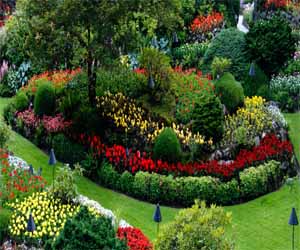


The Power Of Gardening Communities

Gardening is a solo endeavor for many, but it's also an activity that thrives on community and shared knowledge. Gardening communities, whether in the form of local gardening clubs, online forums, or neighborhood co-op gardens, offer numerous benefits beyond the joys of nurturing plants. In this article, we'll explore the significance of gardening communities and the advantages of being a part of one.
1. Shared Knowledge And Expertise: Gardening communities provide a wealth of knowledge and expertise. Seasoned gardeners often share their experiences, offering tips and guidance to beginners. This collective wisdom helps members navigate the challenges of gardening, from plant selection to pest control, and accelerates their learning process.
2. Problem Solving: When faced with a gardening challenge, whether it's a mysterious pest infestation or a stubborn weed problem, being part of a gardening community means you have a network of fellow gardeners to turn to for solutions. Together, members can brainstorm ideas and offer practical advice.
3. Seed And Plant Swaps: Gardening communities frequently organize seed and plant swaps. These events are excellent opportunities to acquire new and interesting plant varieties and share your own surplus plants with fellow gardeners. Such swaps promote diversity and provide access to rare and heirloom plants.
4. Collaboration: In some gardening communities, members collaborate on group projects or communal gardens. These shared spaces allow for the cultivation of larger and more diverse gardens than what individual gardeners might achieve alone. Collaborative efforts can result in flourishing, bountiful gardens that benefit everyone involved.
5. Social Interaction: Gardening is a solitary activity for many, but being part of a gardening community can alleviate the isolation. Whether you're participating in a local club's meetings or engaging in online discussions, these interactions offer the chance to connect with like-minded individuals who share your passion for plants and the outdoors.
6. Garden Tours And Events: Gardening communities often organize garden tours and events where members can visit one another's gardens, exchange ideas, and celebrate each other's successes. These events can be a source of inspiration and an opportunity to appreciate the beauty of different gardening styles.
7. Mentorship: Experienced gardeners within a community often take on mentorship roles, guiding newcomers in the art and science of gardening. Mentorship fosters a sense of continuity and tradition, passing down knowledge from one generation of gardeners to the next.
8. Support And Encouragement: Gardening can be a challenging and occasionally frustrating endeavor. Gardening communities provide emotional support and encouragement during times of setbacks. Members understand the triumphs and tribulations of gardening, offering a sense of camaraderie.
Joining A Gardening Community:
If you're interested in becoming a part of a gardening community, consider these steps:
Research Local Clubs: Search for gardening clubs or groups in your area. Local botanical gardens, community centers, and nurseries may have information on nearby organizations.
Online Communities: Explore online gardening forums and social media groups, where you can connect with gardeners from around the world. Websites like GardenWeb, Houzz, and Facebook groups are popular platforms.
Attend Events: Participate in gardening-related events, workshops, or garden tours to meet fellow gardeners in person.
Share Your Knowledge: Once you're part of a community, share your own experiences and knowledge. The reciprocal exchange of ideas is at the heart of gardening communities.
Gardening communities offer a sense of belonging, mutual support, and the chance to grow as a gardener through shared experiences and knowledge. Whether you're a novice or a seasoned gardener, the power of a gardening community can enrich your gardening journey in numerous ways.
Creating A Beautiful And Thriving Garden
 Assess Your Garden Conditions: Before you begin selecting plants, it's essential to assess your garden's conditions. Consider factors like sunlight, soil type, moisture levels, and climate. Some plants thrive in full sun, while others prefer shade. Some can tolerate dry conditions, while others need consistently moist soil. Understanding your garden's unique environment is the first step in making informed plant selections.
Assess Your Garden Conditions: Before you begin selecting plants, it's essential to assess your garden's conditions. Consider factors like sunlight, soil type, moisture levels, and climate. Some plants thrive in full sun, while others prefer shade. Some can tolerate dry conditions, while others need consistently moist soil. Understanding your garden's unique environment is the first step in making informed plant selections.
Define Your Garden's Purpose: What do you want to achieve with your garden? Are you looking to create a lush, private retreat, or do you aim to grow a bountiful vegetable garden? The purpose of your garden will greatly influence your plant selection. For example, a meditation garden may focus on fragrant and low-maintenance plants, while a vegetable garden will prioritize edible crops.
A Path To Sustainable Resource Management
 Understanding Water Conservation
Understanding Water Conservation
Water conservation refers to the careful and efficient use of water resources to minimize waste and ensure the availability of clean water for present and future generations. It is a multifaceted approach that encompasses a wide range of practices at the individual, community, and industrial levels.
Effective Water Conservation Methods
Fixing Leaks: One of the most basic yet crucial methods is fixing leaks in plumbing systems. A dripping faucet or a leaky pipe can waste significant amounts of water over time.
Low-Flow Fixtures: Installing low-flow faucets and showerheads is an effective way to reduce water consumption without compromising water pressure or functionality.
Dual-Flush Toilets: Dual-flush toilets provide two flushing options, allowing users to select a lower volume for liquid waste and a higher volume for solid waste.






Creative Landscaping Ideas
 2. Xeriscaping: For areas with limited water resources, xeriscaping is the way to go. This landscaping approach focuses on drought-tolerant plants, efficient irrigation systems, and mulching to conserve water. The result is a low-maintenance garden that thrives in arid conditions.
2. Xeriscaping: For areas with limited water resources, xeriscaping is the way to go. This landscaping approach focuses on drought-tolerant plants, efficient irrigation systems, and mulching to conserve water. The result is a low-maintenance garden that thrives in arid conditions.
3. Edible Landscaping: Why not turn your outdoor space into a source of fresh produce? Edible landscaping incorporates fruits, vegetables, and herbs into your garden design. Raised beds, vertical gardens, and fruit trees can create a beautiful and functional space that provides your family with fresh, homegrown produce.
4. Zen Gardens: Zen gardens are known for their minimalist and tranquil designs. These peaceful spaces often feature sand or gravel raked into patterns, along with carefully placed rocks and a few select plants. They provide a sense of serenity and are perfect for meditation or relaxation.
5. Cottage Gardens: Cottage gardens are characterized by their informal, abundant, and colorful arrangements. They typically include a mix of flowers, shrubs, and even some vegetables. The key is to create a slightly wild and romantic atmosphere, perfect for a more rustic and charming look.
6. Rock Gardens: If you have rocky or hilly terrain, consider creating a rock garden. These gardens use the natural features of the land, incorporating rocks, pebbles, and alpine plants. They provide a unique and visually appealing landscape.
7. Vertical Gardens: For small spaces or urban areas, vertical gardens are an excellent option. These gardens make use of walls, fences, or trellises to grow plants upwards, saving valuable ground space and adding a touch of greenery to urban environments.
A Sustainable Solution For A Thirsty World
 Types Of Water Reuse Systems
Types Of Water Reuse Systems
Direct Potable Reuse (DPR): DPR systems treat wastewater to a high standard and then inject it directly into a drinking water supply, bypassing the need for natural recharge. Although this approach is effective, it requires advanced treatment processes and stringent monitoring to ensure water quality and safety.
Indirect Potable Reuse (IPR): IPR systems involve the injection of treated wastewater into an environmental buffer, such as an aquifer or reservoir, before it is eventually extracted for drinking water treatment. This approach provides an additional layer of natural treatment and is considered a safer alternative to DPR.
Non-Potable Water Reuse: Many water reuse systems are designed for non-potable applications. These systems treat wastewater to a level suitable for purposes like irrigation, industrial processes, toilet flushing, and cooling systems in power plants. Non-potable water reuse significantly reduces the demand on freshwater sources for these activities.
Environmental And Economic Benefits
Water reuse systems offer several compelling benefits:
Conservation: Reusing water reduces the amount of freshwater withdrawn from rivers and aquifers, helping protect ecosystems and maintaining their natural flow.
Energy Savings: Treating and transporting water requires energy. By reusing water locally, we reduce the energy footprint associated with long-distance water conveyance.
Innovations For A Sustainable Future
 The Importance Of Water-Saving Technologies
The Importance Of Water-Saving Technologies
Water is a finite and precious resource, and the need for water-saving technologies is underscored by several key factors:
Water Scarcity: Many regions worldwide face water scarcity, where the demand for water exceeds the available supply. This challenge is exacerbated by population growth, urbanization, and climate change.
Sustainability: Sustainable water management practices are crucial to ensure the long-term availability of clean water for future generations and to protect ecosystems that rely on water resources.
Efficiency: Efficient water use is not only environmentally responsible but also financially advantageous, as it leads to cost savings for individuals, businesses, and communities.
Water-Saving Technologies And Innovations
Low-Flow Fixtures: Low-flow faucets, showerheads, and toilets use innovative design and technology to reduce water consumption without sacrificing performance. These fixtures limit water flow while maintaining water pressure.
Smart Irrigation Systems: Advanced irrigation technologies use sensors and data analysis to optimize watering schedules and ensure that landscapes receive the right amount of water. This reduces water wastage from over-irrigation.
The Future Of Modern Living
 What Are Smart Appliances?
What Are Smart Appliances?
Smart appliances are traditional household devices, such as refrigerators, ovens, washing machines, and even coffee makers, that are equipped with advanced technology and connectivity features. These features allow them to be remotely controlled and monitored through a smartphone app or voice-activated virtual assistants. Smart appliances can perform a wide range of functions, from adjusting settings to sending notifications and alerts.
Convenience And Efficiency
One of the most significant advantages of smart appliances is the level of convenience they bring to everyday tasks. Imagine being able to preheat your oven on your way home, so dinner is ready as soon as you arrive. Smart appliances enable you to control and monitor their functions from virtually anywhere, giving you more control over your daily routines.
Energy Efficiency And Cost Savings
Smart appliances are designed to be energy-efficient. They often include features like energy-saving modes, remote scheduling, and real-time consumption tracking. For instance, smart thermostats can learn your heating and cooling preferences and create optimized schedules, which not only improve comfort but also save on energy costs. Smart appliances not only benefit your wallet but also contribute to environmental sustainability.
Integration With Smart Homes
Smart appliances are designed to be compatible with other smart home devices and systems. They can seamlessly integrate with centralized home automation hubs, allowing you to control multiple devices from a single app or voice-activated virtual assistant. This interconnected ecosystem enhances the overall smart home experience.
Voice Control
Many smart appliances can be controlled via voice commands through virtual assistants like Amazon's Alexa, Google Assistant, or Apple's Siri. This feature adds an extra layer of convenience, allowing you to adjust settings or start tasks without needing to touch a button or screen.